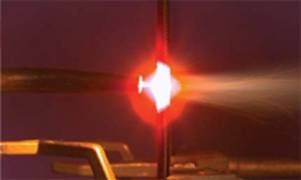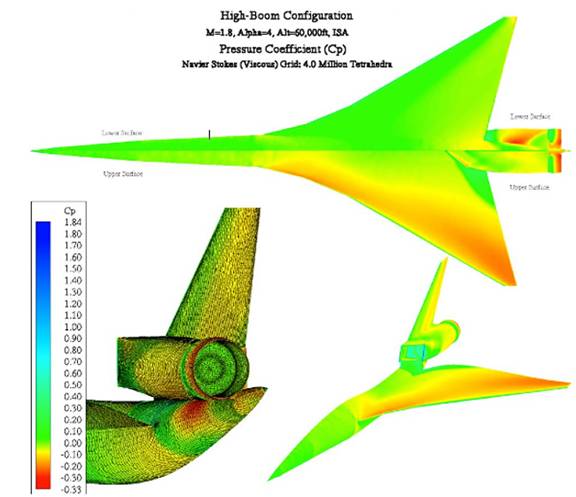



Invention of the Year Awards for 2004
The Government Invention of the Year for 2004 is the Rocket Motor Join Construction Including Thermal Barrier, a unique, braided carbon-fiber thermal barrier designed to withstand the extreme temperature environments in current and future solid rocket motors and other industrial equipment. Developed at NASA’s Glenn Research Center, the new, highly reliable thermal barrier was created for several critical nozzle joints on the Space Shuttle solid rocket motor. The thermal barrier is a revolutionary development that provides an elegant solution to overcome a vexing problem of protecting temperature sensitive O-rings required to seal 60 atmospheres and over 3,000 °C combustion gases.
The new thermal barrier represents a significant improvement over the current joint-fill approach which, on occasion, allows hot combustion gases to penetrate through to nozzle joint O-rings. This important new technology promotes Shuttle and astronaut safety and enables solid rocket motor joint assembly in one-sixth the time of previous approaches with much higher degrees of reproducibility.
The GRC thermal barriers have since enabled successful flights on two Atlas V commercial launches. The thermal barrier and nozzle joint construction approach presented is mission-critical to the Atlas V Launch Vehicle.
The RP-46 High Temperature Resin System, developed at NASA’s Langley Research Center, is the 2004 Commercial Invention of the Year. It has applications in reusable launch vehicles, space exploration systems, advanced aircraft engine components, and numerous other aerospace and non-aerospace programs. The NASA Exploration Initiative "High temperature composite adhesives for reduced mass aeroshells" Project selected RP-46 over other materials. The project's goal is to incorporate state of the art materials into aeroshells with decreased structural mass and increased payload for exploration activities.
The aerospace and non-aerospace communities are rapidly moving to implement LARC RP46 as a low-toxicity replacement material for the current state-of-the art, high-temperature resin. Firms such as Boeing, Northrop Grumman, General Electric, Lockheed Martin, United Technologies, and others have all conducted internally funded research and development on the technology.
Software of the Year Awards for 2004
Tetrahedral Unstructured Software System (TetrUSS), first evaluated in 1996, a suite of computational programs developed at NASA’s Langley Research Center that’s used for fluid dynamics and aerodynamics analysis has been updated to include:
- Viscous Grid / Navier-Stokes capability, which makes TetrUSS a predictive, not a reactive, tool for aviation and exploration.
- Expansion to other hardware platforms, using the OpenGL standard, allowing TetrUSS to be used on the Mac OSX and PC Linux platforms rather than just the SGI/Irix solution previously implemented.
- Advanced turbulence models, adding capability to the USM3D flow solver for simulating complex aerodynamic configurations with propulsion integration using two-equation turbulence models. The overhead of using these models is less than 5% of the total computer time and 1% of memory. As accurate unstructured-grid CFD methods become available for complex aerodynamic applications, the design and analysis time of complex configurations will be dramatically decreased when compared with structured-grid generation.
- Parallel version of USM3D flow solver, which allows virtual linear scalability for problem solving with up to 250 processors reducing processing time by nearly 250-fold.
- Advances in grid generation, wherein an adaptive grid refinement method was developed and successfully applied to several 3D problems. The method is based on automatic local grid refinement. As the flow solution proceeds, areas in the computational domain which require more accuracy are identified. The grid is then automatically refined in these areas, and a new solution is obtained. The process continues until a predetermined objective (usually an accuracy level) is achieved. This is the first time an adaptive unstructured grid was implemented for viscous flow modelling.
- Increased use of TetrUSS in critical NASA, government, and industry programs. TetrUSS is now in use at over 500 sites for all classes of aerospace and industrial fluid flow applications, inside and out of NASA, worth many billions of dollars.
The Science Activity Planner (SAP), developed at NASA’s Jet Propulsion Laboratory, combines cutting-edge visualization with sophisticated planning and simulation capabilities to provide an intuitive interface to Mars rovers and landers. It is a multi-mission, multi-purpose tool that has achieved three simultaneous successes in mission operations, public outreach, and technology development.
SAP comes in two versions. The first is used in mission operations and contains the official mission activity dictionary. The second version was released under the name Maestro to the public for education and outreach. Maestro includes additional training features that make it a more effective tool for public engagement.
SAP is used heavily in the Mars Exploration Rover (MER) Mission on a daily basis. Scientists on the MER mission depend on SAP as their primary interface to the Spirit and Opportunity rovers. Every day, mission scientists and engineers use SAP to plan the next actions of the rovers and analyze the data arriving from Mars. SAP is a Class-A, mission-critical part of the rovers' operations subsystem and is a vital part of mission operations. At the time this application was written, SAP had completed over 250 sols of successful mission operations of the Spirit and Opportunity rovers without a single critical failure and will continue to serve this role until the end of the mission.
This is a logical extension of the tool known as WITS, which won acclaim in the 1998 Software of the Year competition.
 ICB Home
ICB Home Back
Back

